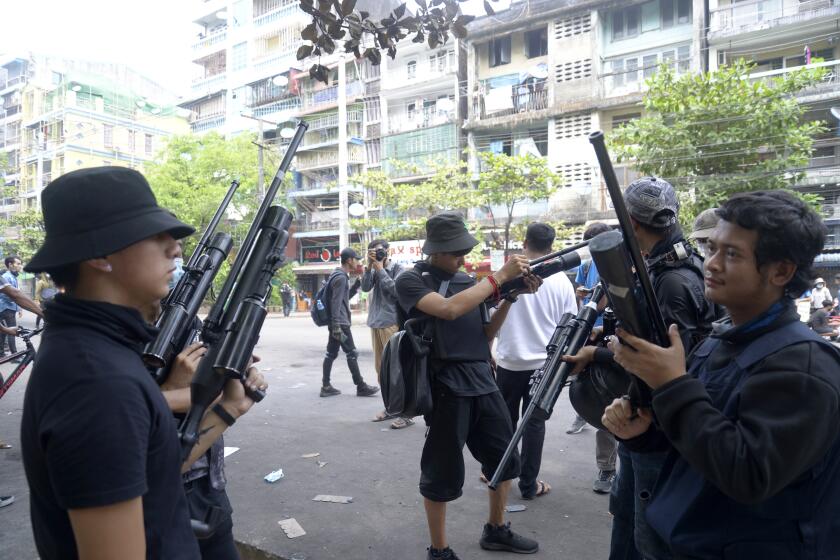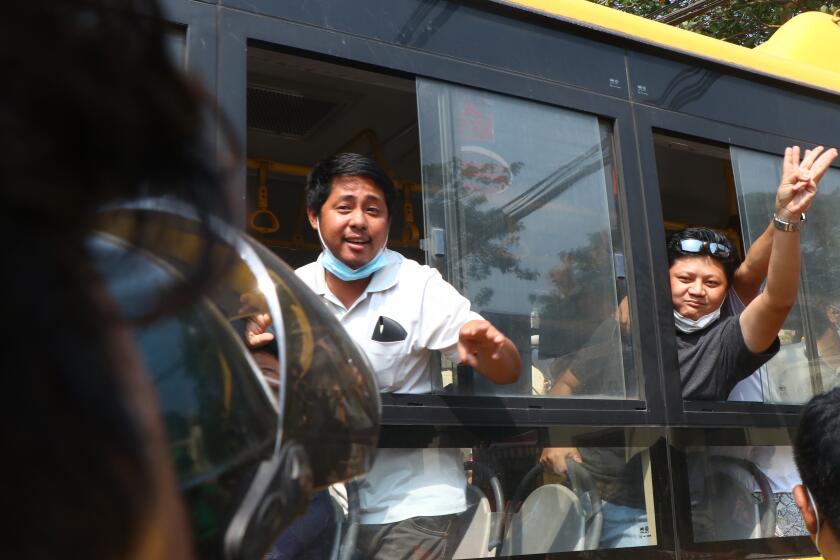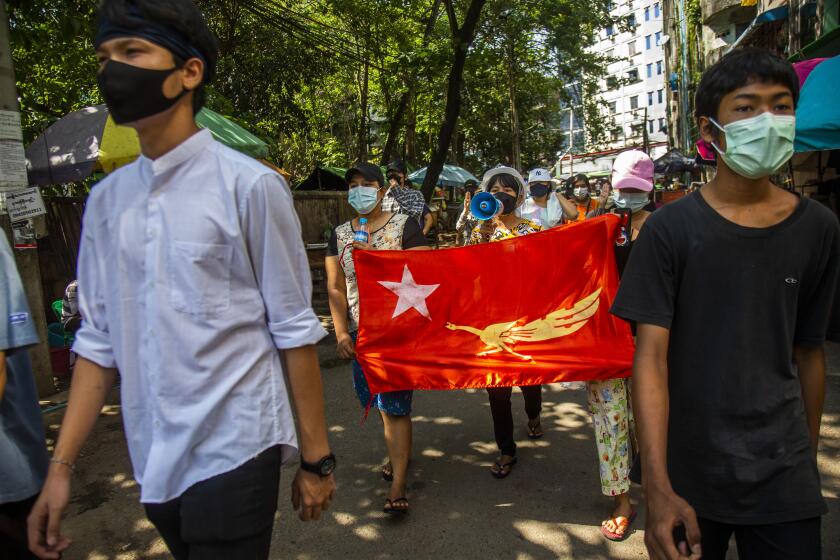Boys and young men disappear in Myanmar military’s crackdown

- Share via
JAKARTA, Indonesia — Myanmar’s security forces moved in, and the street lamps went black. In house after house, people shut off their lights.
Huddled inside her home in Yangon, 19-year-old Shwe dared to peek out her window. A flashlight shone back, and a man’s voice ordered her not to look.
Two gunshots rang out. Then a man’s scream: “Help!” When the military’s trucks finally rolled away, Shwe and her family emerged to look for her 15-year-old brother, who was nowhere to be found.
“I could feel my blood thumping,” she recalled. “I had a feeling that he might be taken.”
Across the country, Myanmar’s security forces are arresting and forcibly disappearing thousands of people, especially boys and young men, in a sweeping bid to crush a three-month uprising against a military takeover.
In most cases, the families of those taken don’t know where they are, according to an Associated Press analysis of more than 3,500 arrests since February. UNICEF, the United Nations children’s agency, is aware of about 1,000 cases of children or young people who have been arbitrarily arrested and detained, many without access to lawyers or their families.
Anti-coup demonstrators are abandoning peaceful protest for armed resistance as the deposed civilian government appeals to ethnic rebels to join the fight. The United Nations warns of a ‘bloodbath.’
It is a technique that Myanmar’s military has long used to instill fear and crush pro-democracy movements. The boys and young men are taken from homes, businesses and streets. Some end up dead. Many are imprisoned and sometimes tortured. Many more are missing.
“We’ve definitely moved into a situation of mass enforced disappearances,” said Matthew Smith, cofounder of the human rights group Fortify Rights, which has collected evidence of detainees being killed in custody. “We’re documenting and seeing widespread and systematic arbitrary arrests.”
The AP is withholding Shwe’s full name to protect her from retaliation by the military.
The autobody shop in Shwe’s neighborhood was a regular hangout for local boys. On the night of March 21, her brother had gone there as he usually did.
Protesters say labor strikes and civil disobedience are the only ways to dislodge the military dictatorship in Myanmar. It may mean pushing millions into poverty.
As Shwe approached the shop, she saw it had been ransacked. Frantic, she and her father scoured the building for any sign of their beloved boy.
But he was gone, and the floor was covered in blood.
Ever since Myanmar’s military seized control in February, faces of the missing have flooded the Internet. Recently, photos of young people detained by security forces also have begun circulating online and on military-controlled television, their faces bloodied, with clear markings of beatings and possible torture.
At least 3,500 people have been detained since the military takeover began, more than three-quarters of whom are male, according to an analysis of data collected by the Assistance Assn. for Political Prisoners, which monitors deaths and arrests. Of the 419 men whose ages were recorded in the group’s database, nearly two-thirds are under age 30, and 78 are teenagers.
Indonesia’s president says Southeast Asian leaders have demanded an immediate end to killings and the release of political detainees in Myanmar
Nearly 2,700 of the detainees are being held at undisclosed locations, an AAPP spokesman said.
“The military are trying to turn civilians, striking workers and children into enemies,” said Ko Bo Kyi, AAPP’s joint secretary. “They think if they can kill off the boys and young men, then they can kill off the revolution.”
After receiving questions from the Associated Press, the military, known as the Tatmadaw, called a Zoom news conference, during which it dubbed the AAPP a “baseless organization,” suggested its data were inaccurate and denied that security forces were targeting young men.
“The security forces are not arresting based on genders and ages,” said Capt. Aye Thazin Myint, a military spokeswoman. “They are only detaining anyone who is rioting, protesting, causing unrest or any actions along those lines.”
The United States is urging the international community to take “concrete action” against the military in Myanmar — including an arms embargo and sanctions against its holding companies and those who profit from them.
Some of those snatched by security forces were protesting. Some have links to the military’s rival political party. Others are taken for no discernible reason. They are typically charged with Section 505(A) of the Penal Code, which, in part, criminalizes any comments that “cause fear.”
Myanmar human rights activist Wai Hnin Pwint Thon is intimately acquainted with the Tatmadaw’s tactics. Her father, famed political activist Mya Aye, was arrested during a 1988 uprising against military rule, and the family waited months before learning he was in prison.
He was arrested again during this year’s military takeover. It was two months before his family discovered he was being held at Yangon’s notorious Insein prison.
“I can’t imagine families of young people who are 19, 20, 21 [and] in prison,” she said. “I’m trying to hold onto hope, but the situation is getting worse every day.”
Start your day right
Sign up for Essential California for the L.A. Times biggest news, features and recommendations in your inbox six days a week.
You may occasionally receive promotional content from the Los Angeles Times.
The military’s scare tactics have proven enormously effective. Across the country, residents regularly take turns holding night watches, banging pots and pans or yelling to neighbors from the street if soldiers or police are spotted.
“I am more afraid of being arrested than getting shot,” said one 29-year-old man who was arrested, beaten and later released, and who spoke on condition of anonymity to avoid retribution. “I have a chance of dying on the spot with just one shot. But being arrested, I am afraid that they would torture me.”
In Yangon, Shwe tried to convince herself that the blood on the floor of the shop wasn’t her brother’s.
He and three other young men from the shop had been hauled away. Neighbors said security forces may have targeted the boys because they spotted someone inside the shop with a steel dart slingshot.
Asia policy: U.S. sanctions have left the rights-abusing junta unbowed but vulnerable to Beijing.
At 2 a.m., a police officer called to say Shwe’s brother was at a military hospital and had been shot in the hand.
Shwe said her family told the police that her brother was underage. But on March 27, they learned that her brother and the three others had been charged with possession of weapons and sentenced to three years in prison.
They were allowed one brief phone call with him when he was first hospitalized, and nothing since. Shwe remembers hearing her brother tell their anguished mother: “I am OK.”
Shwe has no idea if that is still true. She worries for her brother, a quiet boy who loves playing games. She worries, too, for their mother, who cries and cries, and for their father, who aches for his only son.
For now, they can do little more than wait and hope: That he won’t be beaten. That he will get a pardon. That the people of Myanmar will soon feel safe again.
“Even though we are all in distress, we try to look on the bright side that at least we know where he is,” she said. “We are lucky that he was only abducted.”
More to Read
Sign up for Essential California
The most important California stories and recommendations in your inbox every morning.
You may occasionally receive promotional content from the Los Angeles Times.

















